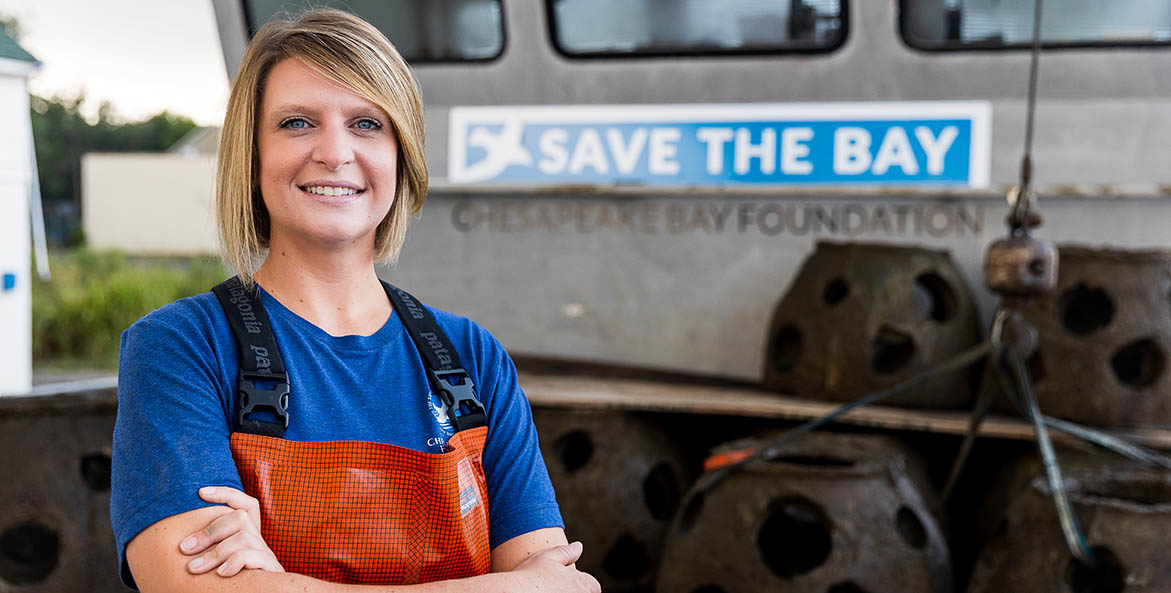Contents
Dr. Allison Colden, Maryland Senior Fisheries Scientist Hilary Harp Falk, CEO and President Tiffany Granberg, Arthur Sherwood Environmental Education Program Captain/Program Manager Taylor Lilley, Environmental Justice Staff Attorney Dr. Beth McGee, Director of Science and Agricultural Policy Brenda Sieglitz, Making History Campaign Assistant Director Gabby Troutman, Virginia Grassroots Coordinator Codi Yeager, Senior WriterA scientist calmly and expertly championing oyster restoration in the halls of Congress, the Maryland State House, and on countless fishery advisory groups; a captain educating hundreds of students and teachers on Chesapeake waters year after year; an environmental justice lawyer advocating for communities that have been left behind—these are just three of the extraordinary women across CBF that have pushed barriers in conservation and science. In honor of Women's History Month, we asked just a few of these talented women what inspires them each and every day to keep pushing the save the Bay movement forward.
Dr. Allison Colden, Maryland Senior Fisheries Scientist
Who is your environmental hero?
Dr. Ruth Turner. She was the first woman marine biologist to dive in the submersible, Alvin. I remember reading about Alvin when I was young and thinking about how inspiring it must be to explore the depths of the ocean and see things that no one on the planet had seen before firsthand. She was a respected leader in marine science during a time when it was predominantly a man's field, and I respect and admire her for paving the way for women scientists like me.
What brought you to the Bay and its rivers?
The Bay has always been in my blood. I grew up in Virginia Beach where the Bay meets the Atlantic Ocean. I spent countless hours at the Virginia Aquarium exploring the underwater world that was right outside my door. It inspired me to want to learn more about the Bay and to protect it.
Why do you do what you do?
I like to think that I speak for the voiceless. It is my job to give the Chesapeake Bay and all the creatures that depend on it a voice in the places where policy is being made. I feel good knowing that I can use my background and knowledge as a scientist to help shape policies that are good for the Bay.
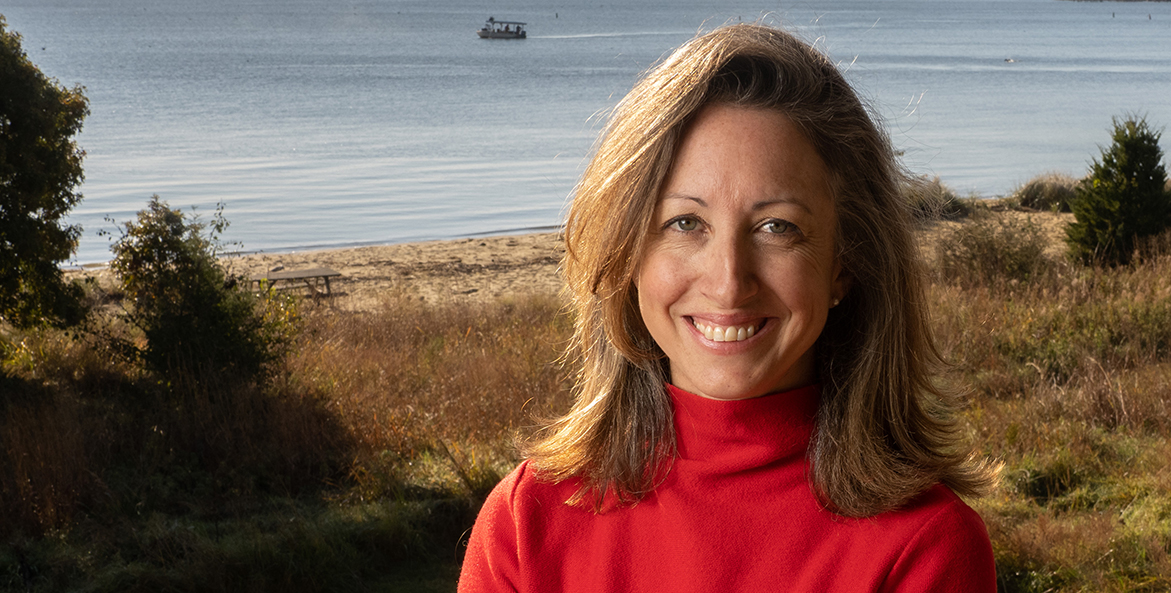
With deep Chesapeake roots, Hilary Harp Falk takes the CBF helm during a critical time for Bay restoration.
Dave Harp
Hilary Harp Falk, CEO and President
Who is your environmental hero?
There are many but Rachel Carson is a big one, partly because she's a Pennsylvanian and grew up in the Bay watershed. She was a pioneer in her work. And she uncovered and focused everybody on the impact of DDT and what that was doing to wildlife and people all at the same time. I can't imagine how hard that must have been. She and her work created the modern environmental movement. Her book Silent Spring is one of the textbooks that we all read now on the importance of protecting the environment and human health.
What brought you to the Bay and its rivers?
Maybe who brought me to the Bay and its rivers is a better question, and that is my dad [Dave Harp]. My dad was doing a story on Smith Island, and he took me there over the course of several years. I loved being on assignment with him. He was taking pictures all across the watershed. My favorite assignments were the ones right on the Bay, where one truly had the opportunity to do something which he calls "being there." You can't take a picture, you can't experience it without being there. We did that a lot when I was growing up. Even though I grew up in Baltimore City, it was those experiences on the Bay that were very foundational. And I knew at that age that I would be in conservation for the rest of my life.
As for the Bay itself—there's no greater joy than "messing around in boats," and the fact that I got to do that with my dad was always really special. My dad is a traditional photojournalist, and one of the things he's always been focused on is people in places. I think the Chesapeake Bay is so unique because there are all these people—whether its farmers or watermen—who are deeply connected to and part of the Bay watershed.
Why do you do what you do?
I love the ability to work on environmental issues. What a wonderful thing it is to be able to wake up every day and work on a set of critical issues—whether it's improving water quality or land use. I can't think of a more invigorating, challenging place to spend a career than in the world of environmental conservation.
What's more, I noticed early on in my career that there weren't a lot of women in leadership roles. And I didn't see a lot of people in leadership roles that were empowering, collaborative, and optimistic. I wanted to prove that you could be all of those things and be a leader. I still feel that's important.
What are some of the unique strengths you believe women bring to environmental movements?
I do think women bring an incredible amount of empathy to their work in their relationship to other people that's absolutely necessary in our collective success. People used to call it "soft skills" and now it's just "skills," because we all know that relationships and organizations work on trust and building people up. Those are all common strengths with women. On the other side of the pandemic, it's clearer and clearer that being very honest about the challenges but kind and direct is a very successful leadership model at a time of great disruption.
BONUS: What's your favorite bit of inspiration for the week?
Secretary of the Interior Deb Haaland recently spoke at South by Southwest. At one point she says, "leave the ladder down for more people to climb." I was particularly struck by her piece and the opportunity for women to leave the ladder down for other women, in particular women of color who have more barriers and fewer opportunities in leadership. Secretary Haaland just nailed it. It was a wonderful piece about the importance of representation, to be able to see yourself and represent your experiences in leadership roles. Auntie Deb is so wise.
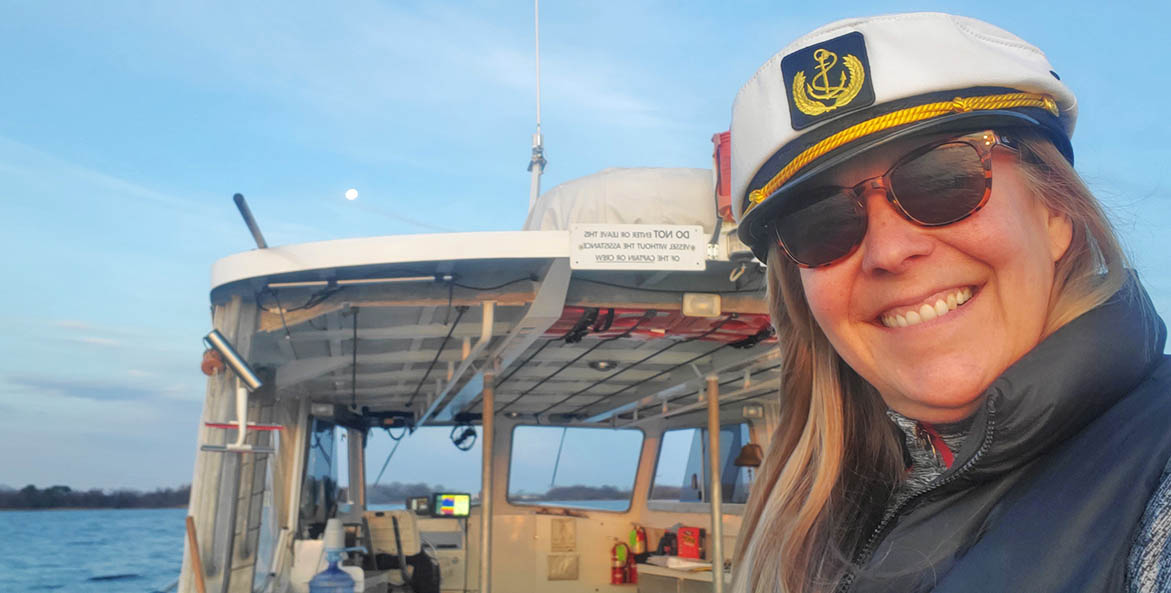
CBF Arthur Sherwood Environmental Education Program Captain/Program Manager Tiffany Granberg has dedicated more than 20 years of her life to educating the next generation of Bay stewards.
Captain Tiffany Granberg, Arthur Sherwood Environmental Education Program Captain/Program Manager
Who is your environmental hero?
Dr. Seuss's The Lorax. I spent several years living and working at CBF's Port Isobel Island Education Center, and a regular part of our programming was to read The Lorax to students at bedtime—so much so that I and many other educators learned the story by heart. What I realized is that the hundreds of students that came out on our experiences over the years also knew the story and understood the environmental messages within it. Many are familiar with the mustached creature who urged environmental responsibility and spoke out for the rights of all creatures. The Lorax was representing those who could not speak for themselves, "for they have no tongues." And he spoke for those whose lives would be severely impacted due to loss of habitat from unchecked development. What I particularly appreciate about the story is at the end that tenacious little Lorax drops a seed of hope with a message that "UNLESS someone like you cares a whole awful lot, nothing is going to get better, it's not." I have worked in the environmental education field for more than 20 years, and I saw many of the students who came through our program, who listened deeply to those words, who acted on behalf of our environment as my environmental heroes. The EBay's (Elysa Miller) and James Hemphills of 2010 were coming out on our programs and planning and implementing these impressive community projects, finding funding and support, organizing events in middle and high school, and in some cases, eventually becoming my co-educators at CBF. I am so proud of the next generation of Loraxs.
What brought you to the Bay and its rivers?
My family would spend summer vacations in Cape Charles, Virginia. In the 1990s, we purchased a big old home on Somerset Avenue in Crisfield Maryland—a big change from Staten Island, New York, where I grew up. My dad loved fishing and crabbing so we got to do a lot of that in the summers. After attending college at the University of Maryland, College Park, where I had three beloved roommates from small towns on Maryland's Eastern Shore (Chestertown, Genelia, and Rock Hall), I fell deeper and deeper in love with the Bay. I spent many weekends driving on marshy backroads, or fishing and floating on the Sassafras River, or competing in the raft races at the Chestertown Tea Party. It was so different from the rivers where I grew up along in Staten Island. At the end of my hometown block was Caddell Dry Docks where big ships would come in for service repairs or bottom paint, and the iconic red Moran Tugboats would guide huge container ships from New York Harbor, passing through on the way to the New Jersey Port Authority under the Bayonne Bridge.
Why do you do what you do?
I grew up going down to the Staten Island waterfront with my dad. We'd walk down to a bulkhead on the other side of industrial train tracks at the end of our street to watch the tugs and ships go by. My uncle is a pilot boat captain, and he would tell my dad when he would be going past. When he would see us on the shore waving, he would toot the ship's horn. I don't think I would have ever believed that one day I would have my own captain's license and operate a research vessel. I just knew that whatever career I chose, it would have to be non-traditional in the sense that I knew I couldn't sit at a desk and stay focused on tasks regularly. I have attention deficit disorder that was not diagnosed until I was an adult. I struggled with traditional learning styles and school was not fun for me until college. But one of my courses at the University of Maryland really inspired me. It was History of the Chesapeake Bay. It introduced me to environmental education and research vessels. After taking it, I knew right then and there that I wanted to pursue that line of work. I joined the School of Independent Studies and created my Environmental Advocacy Major. I have been with the Bay Foundation for more than 20 years as an educator and worked as a first mate on different boat programs. I have been a captain on the Marguerite at our Arthur Sherwood Environmental Education Program for the last five years.
I hope that young women who attend our programs see me as a role model. Five or ten years ago, I was the first mate on the Marguerite, and there were many program days where I was also the only female on the boat. Now we have an all-female boat crew! And there have been days where we had all girl schools out with our all-female boat crew. It is empowering, encouraging, and hopefully inspiring to those young ladies. The traditional male-female roles in the workforce are changing.
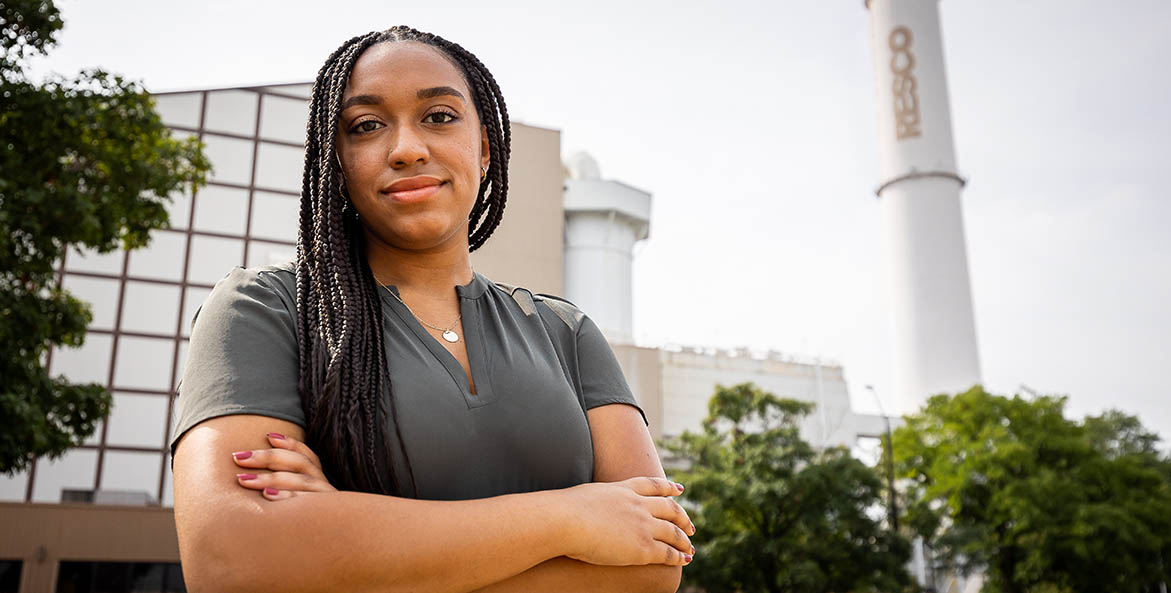
CBF Environmental Justice Staff Attorney Taylor Lilley has helped push for environmental justice in areas like Baltimore, where the city’s Wheelabrator trash incinerator causes $55 million annually in health problems.
Caroline Phillips
Taylor Lilley, Environmental Justice Staff Attorney
Who is your environmental hero?
My environmental heroes are Robert Bullard and Dorcetta Taylor. Dr. Robert Bullard is known as the father of the environmental justice movement. In addition to being at the forefront of the fight against environmental racism in the 1980s, his novel Dumping in Dixie sheds light on the injustices experienced by communities of color in the U.S. His contributions to the environmental justice movement have been invaluable, and his dedication continues to this day. When I feel overwhelmed by my work and the stories that I hear from impacted residents in the Bay region, remembering how much effort Dr. Bullard has put into this fight inspires me to keep going.
Like Dr. Bullard, Dr. Dorcetta Taylor's expertise is in the field of environmental sociology. I came to know Dr. Taylor through her discussions of the American Conservation Movement, specifically her exploration of how the rise of environmentalism in America relates to social dynamics such as race, gender, and class. I have often felt like an outsider in the environmental field—Dr. Taylor's work helped (and continues to help) me understand my own relationship with environmentalism. Throughout my career, I haven't always been sure where I fit in, or what I could do to contribute. Through their work, Dr. Bullard and Dr. Taylor helped broaden my understanding of what it means to be an environmentalist and an environmental justice advocate.
What brought you to the Bay and its rivers?
I fell in love with nature playing in the canals and inlets of my hometown in south Florida. The love of nature that I cultivated growing up is what inspired me to pursue a career in the environmental field. When I left Florida to come attend law school in Baltimore, I often found myself missing my home state and the wilderness that I had been raised in. When I was introduced to CBF, it immediately became clear to me how passionate everyone was about the fight to Save the Bay, and it reminded of me of the passion for the environment that compelled me to become an environmental lawyer. While that alone was enough for me to accept a job, my work with communities and the time I've spent learning from my colleagues over the past three years has helped me build a connection to the Chesapeake Bay watershed. Over the last few years I've learned about the Bay from educators, lawyers, scientists, residents, and students. Through my conversation and experiences, I always find something new to appreciate, and another reason to fight to Save the Bay—for everyone.
Why do you do what you do?
As someone who often felt like an outsider in the environmental field, I enjoy supporting communities the environmental movement has left behind and giving them a voice. I've often heard that communities of color and environmental organizations don't care about the same things. I like to believe that my work helps to show just how inaccurate that is.
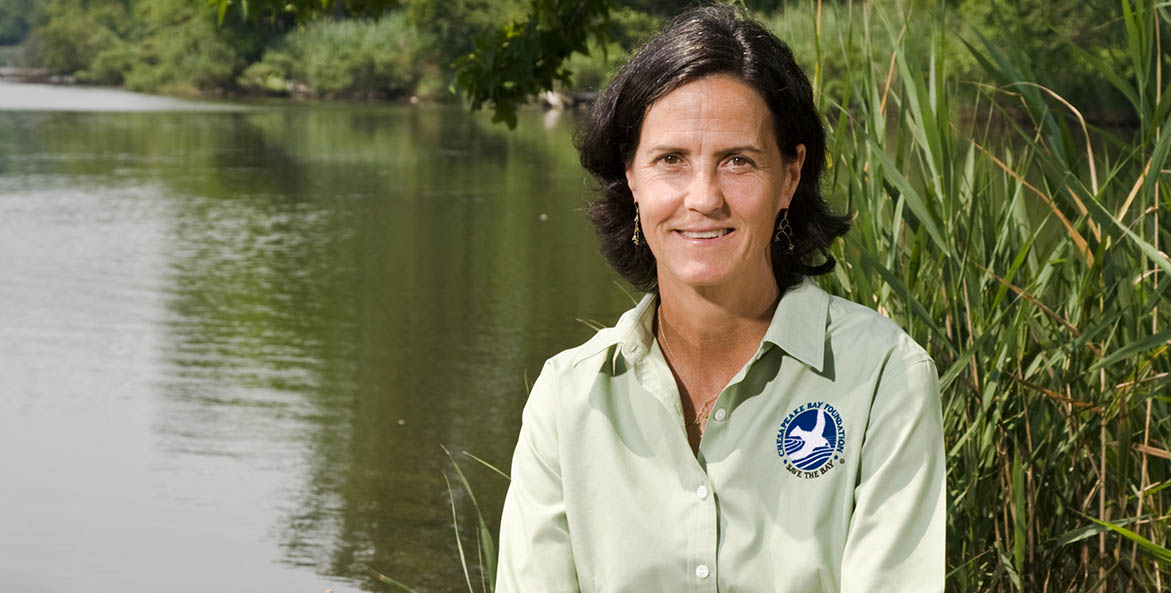
CBF's Director of Science and Agricultural Policy Beth McGee.
Benjamin Tankersley.
Dr. Beth McGee, Director of Science and Agricultural Policy
Who is your environmental hero?
Rachel Carson. Besides the fact that she has local roots, she was a trailblazer, was courageous, smart, and inspirational. A biologist (and former Fish and Wildlife employee—near and dear to my heart) and her writings about concerns about toxic chemicals were transformational. Kim Coble [Maryland League of Conservationist Executive Director and former CBF VP] would be a close second!
What brought you to the Bay and its rivers?
Believe it or not, originally a solicitation from the Chesapeake Bay Foundation sent to my home in Wilmington, Delaware, when I was about 10 years old. I always loved prowling around streams and in the woods and had a strong passion for the environment. When I saw that notice, I thought to myself . . . well that would be a cool place to work when I grow up! I took a circuitous path to get to CBF, but at the end of the day, interesting that I landed here, huh?
Why do you do what you do?
My title is Director of Science and Agricultural Policy so I try to leverage our on- the-ground experience with farmers to help make policies that work. Also, I try to promote regenerative agriculture by highlighting the benefits to the public and to farmers and hoping to create policy incentives for farmers to adopt them. I also consider myself the "lead fact checker" at CBF—our reputation is built on our credibility, and I take that role very seriously.
What are some of the unique strengths you believe women bring to environmental movements?
Speaking for myself, I try to be a good listener and problem solver. The older I get, the less I see the world as not black and white, but gray. So there's room for compromise and understanding. I'm a "people person" drawing energy from interacting with others and their ideas, and I think good solutions come from hearing and vetting different perspectives. I realize one can be a strong advocate for the environment, but still be respectful—not overbearing.
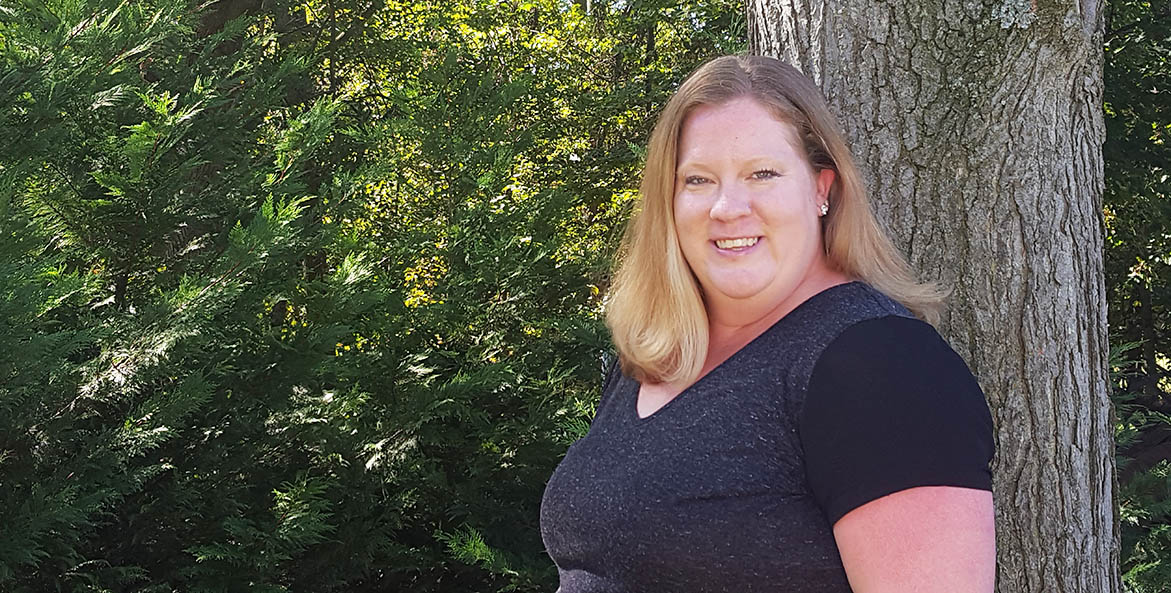
Brenda Sieglitz, CBF Making History Campaign Assistant Director.
Brenda Sieglitz.
Brenda Sieglitz, Making History Campaign Assistant Director
Who is your environmental hero?
Rachel Carson. I admire how she dedicated her life to investigating issues that were devastating the natural community. She stood up to the industry causing these devastating impacts on bird populations all while silently battling cancer. It is inspiring when women find the vigor to battle causes beyond their own personal challenges.
What brought you to the Bay and its rivers?
The bay watershed has always been my home; I was born and raised in Lancaster County, Pennsylvania. As soon as I learned how to drive, my girlfriends and I often drove down to the Bay for an evening in Chesapeake City, Havre de Grace, or to the southern Susquehanna town of Port Deposit. It felt like the perfect escape on a humid summer night. While I moved away for two brief periods in my life, I came back because of the magnetic pull this beautiful place has on my soul. Every time I came back I found new reasons to protect the places that have always been so sacred to me.
Why do you do what you do?
I lost my first husband to cancer in 2008, and in that time of grief I sought solace in the woods of Pennsylvania. The woods brought a lot of calm to the anxiety I was facing. I began sharing with others about the importance of nature to the healing process and realized how important it was to protect these sacred spaces around us. Now, as I visit those same places with my husband and dogs, I am so excited to see the preservation and restoration of our forests. I know that these woods and the nature around us will bring a lot of healing to others as well as to our planet.
What are some of the unique strengths you believe women bring to environmental movements?
Empathy, passion, and strategic direction. I am so fortunate to work with many women partners in the Keystone Partnership. These leaders provide inspiring direction and decision making that is critical to not only meeting our immediate needs, but to looking years ahead at evaluating the impacts these decisions will make on our future. The empathy and passion each of these women bring to our brainstorming sessions is a wonderful addition to our toolbox.
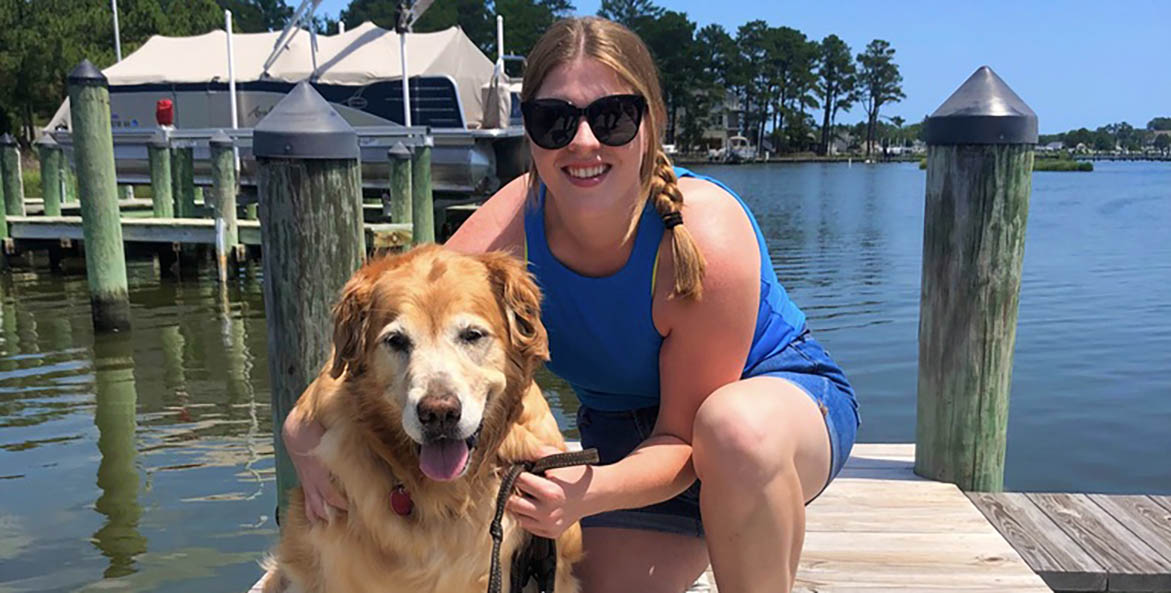
CBF Virginia Grassroots Coordinator Gabby Troutman with her dog.
Gabby Troutman.
Gabby Troutman, Virginia Grassroots Coordinator
Who is your environmental hero?
I have two female environmental heroes that come to mind; one from the past, and one who gives me hope for the future. Marjory Stoneman Douglas serves as an inspiration to me. She worked tirelessly to raise awareness that the Everglades was a critical resource and an essential part of Florida's ecosystem. She fought against proposals to drain the swamps and to develop lands, and she ultimately redefined the Everglades as a national treasure, resulting in the creation of Everglades National Park. I also have immense hope for the future thanks to the international attention Greta Thunberg drew to climate change and the severe impacts it will have upon young and future generations. Climate change impacts can be daunting to consider, but I am encouraged by the awareness and dedication of young leaders like Thunberg.
What brought you to the Bay and its rivers?
Despite growing up in South Central Pennsylvania, I was lucky to spend a great deal of time visiting my grandparents' home along the Elk River and being able to swim, fish, crab, and boat in the Bay. During my final years in high school, I had the opportunity to visit CBF's Karen Noonan Center to learn about the Bay firsthand, and those experiences were transformative. I had always had an interest in biology and the environment, but my experiences with CBF were what inspired me to study environmental science in college with a concentration on coastal and watershed studies. I hoped that I would be able to one day join the organization. And after earning my degree and working as a member of the Chesapeake Conservation Corps, I was thrilled to accept a position in CBF's Richmond office.
Why do you do what you do?
I love working with local volunteers to improve the health of the James River and our local waterways here in Central Virginia. But what really drives me is the unique history of Richmond. Historical redlining in the city led to long-term disenfranchisement of neighborhoods which now lack green spaces and consequently have poor health and environmental outcomes. I enjoy working with partner organizations and community members to increase green spaces and improve water quality while simultaneously addressing community needs. Our watershed is incredibly diverse, and I see so many opportunities for environmental organizations to transform the way that we interact with communities to ensure residents are supportive of changes being made. Working with the community rather than just in the community can ensure we have a bigger impact long-term.
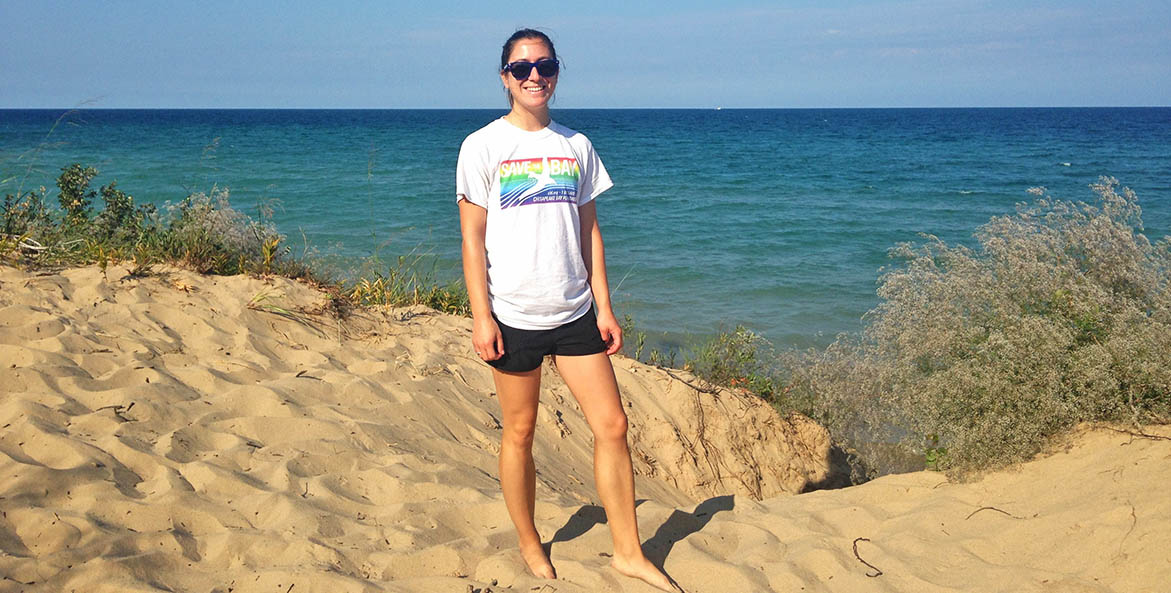
CBF Senior Writer Codi Yeager standing on the shores of her native Lake Michigan showcasing her CBF T-shirt.
Codi Yeager.
Codi Yeager, Senior Writer
Who is your environmental hero?
My mom. Her environmentalism has always been really grounded in a wonder and love for the world—she taught me the importance of seeing all living things as having intrinsic value; the importance of knowing their names and habits; and the power of observation. She's also one of the most practical environmentalists I know. She cares about getting things done, especially locally. I have a lot of childhood memories of planting and taking care of trees at the county park, some of which are now pretty big, and they've really transformed what used to be a hot, weedy field into someplace where kids and families enjoy time. It really drives home that environmentalism isn't something abstract, it's something you live, and you can make a difference in people's lives no matter the scale.
What brought you to the Bay and its rivers?
I grew up in northern Michigan and spent my early career as an environmental journalist writing about the Great Lakes. In particular, I wrote a lot about toxic algal blooms in Lake Erie, which stem from many of the same pollution sources that we see in the Chesapeake Bay. I remember interviewing experts from the Bay restoration effort, and even looking at CBF's State of the Bay report, and it became very clear that the Bay region is on the leading edge of solving these problems. If it's going to happen anywhere, it's going to happen here—I don't think people are always aware how special and rare it is to have the political, legal, and social capital that the Bay restoration framework has. So I came to this area because I truly believe that the fate of clean water across the country, and really the world, depends on getting things right here. We have that power.
Why do you do what you do?
It's part awe and endless curiosity about the natural world. Science is cool. There's always something new and fascinating to learn, and it's often crazier than fiction. It's also part necessity. We are at a really dangerous moment in time for our world in terms of climate change, the loss of species, really large-scale collapse of the systems that we depend on for our food, our health, our economies—so many things. People are waking up to the fact that the environment isn't superfluous, but we need to act faster. I've always thought that if people understand a problem, and if they care about it, then they'll fix it. It's not that simple, of course, but my goal is to help create that understanding and caring by humanizing and making relatable issues that are often complex and wonky. Because the world's future literally depends on us understanding and caring enough to do something about them.
What are some of the unique strengths you believe women bring to environmental movements?
I'm hesitant to generalize, because the women I've known in the environmental movement are all so different and each brings their own strengths. I think regardless of gender, having more people from more backgrounds, with different life experiences, is beneficial—and necessary—for the success of environmental movements. We all live in the world, but our experiences of it can be wildly different. The more perspectives we include, the more accurate and effective our efforts will be.

Issues in this Post
Chesapeake Clean Water Blueprint About CBF Community Women's History and the Bay

